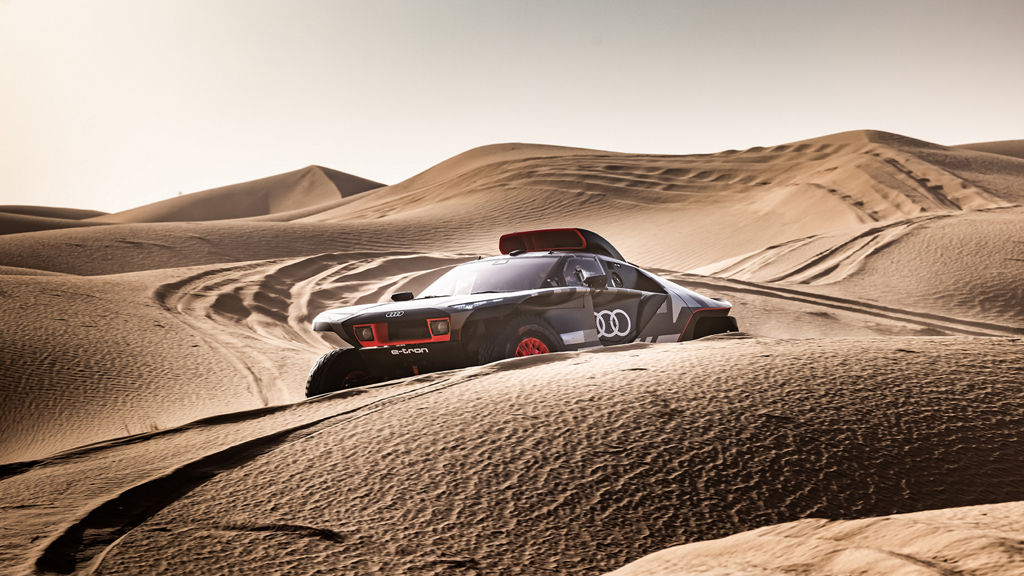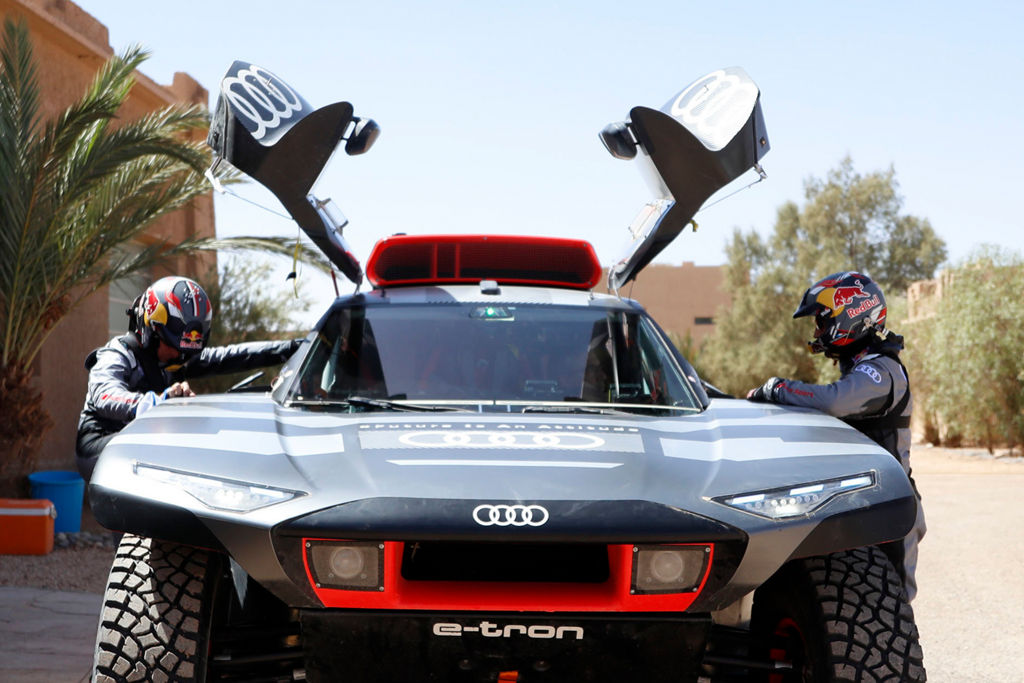“As a racing driver, what more can you ask for?”
missing translation: fa.article-intro.reading-time – Copy: AUDI AG - Photo: Julian Rausche, AUDI AG - Video: AUDI AG – 05/04/2023
This vehicle shown here is the Rally Dakar vehicle that is not available as a production model.

Tested in Morocco in summer 2021, the first generation Audi RS Q e-tron* was ready for Stéphane Peterhansel‘s and Edouard Boulanger‘s challenge in the desert of Saudi Arabia.
Closed course, professional driver. Do not attempt.
Tested in Morocco in summer 2021, the first generation Audi RS Q e-tron* was ready for Stéphane Peterhansel‘s and Edouard Boulanger‘s challenge in the desert of Saudi Arabia.
Closed course, professional driver. Do not attempt.
Edouard, what exactly is your role as a co-driver?
Edouard Boulanger: Actually, it’s quite a multifaceted job that has become even more complex in recent years. Most people probably associate it with navigating. But as technology in cars advances, so the amount of navigating I do decreases. Strict navigation is only 50 percent of my duties. Today, a co-driver has to manage the car, especially all the electronic functions and act as the interface between the vehicle and the driver. I try to make Stéphane’s life as easy as possible.
It sounds like a very demanding job with long working hours.
Edouard Boulanger: I would be lying if I said it wasn’t. During the Dakar Rally, my day starts early in the morning and ends late in the evening when I brief the engineers. And let’s not forget the actual racing in between, which is a complex and sometimes stressful matter. You can’t afford to overlook any detail in the roadbook; otherwise you risk losing time or, what’s worse, getting lost. Meanwhile, you also need to keep a close watch on the car’s parameters so as not to sacrifice efficiency. Increasingly, being a rally co-driver requires mental agility.
So what makes a good co-driver?
Edouard Boulanger: There are two main things: First, there are the physical stresses. You have to be really fit to handle all the knocks you take during a stage. Usually, I can’t anticipate the bumps because I’m looking at the roadbook, not the track. As I said, mental agility is the other half of the equation. One moment, a co-driver will be checking the roadbook, the next, he is adjusting something on the car. All the while you’re passing vital information on to the driver.
Stéphane Peterhansel: I’d like to add that co-driving is about precision, too. All the information conveyed to the driver needs to be communicated precisely and without ambiguity. You have to remember that all these tasks are performed over hours of racing in extreme conditions.

Edouard Boulanger mastered the Dakar Rally in various functions. In 2021, he started together with Stéphane Peterhansel for the first time and won the rally outright.

“Mister Dakar” Stéphane Peterhansel is a legend in his sport. He has won the Dakar Rally 14 times, which includes six victories on a motorcycle and eight in a car.
Edouard Boulanger mastered the Dakar Rally in various functions. In 2021, he started together with Stéphane Peterhansel for the first time and won the rally outright.
“Mister Dakar” Stéphane Peterhansel is a legend in his sport. He has won the Dakar Rally 14 times, which includes six victories on a motorcycle and eight in a car.
In other words, you need to be in top shape, right?
Edouard Boulanger: The car’s weakness is the occupants’ bodies. While we don’t need to be bodybuilders, we need to be able to withstand punishment for hours.
Mr. Peterhansel, is it the same for a driver?
Stéphane Peterhansel: No, it’s different. As a driver, I’ve got my eye on all the track’s uneven patches, so I can prepare to brace for most of those bumps Edouard talked about. Of course, drivers also need endurance.
Edouard Boulanger: A good driver’s main skill is the ability to stay focused for hours. Going fast for a few minutes isn’t too difficult. Doing it over a whole day for fifteen days in a row is a different story. I have been on Stéphane’s team for a year now and what never ceases to amaze me is how consistent he is from the first to the last minute. It is pretty awesome.
So it’s kind of a symbiotic relationship – you need each other to be successful. What are the prerequisites to finding a perfect fit?
Stéphane Peterhansel: For me, it’s really important that we speak the same language. In our case, that’s French. On top of that, Edouard and I share similar backgrounds in a variety of different motorsports. You need to have an almost metaphysical connection so that you see things the same way.
Edouard Boulanger: When we are racing, we don’t have time to think about what we are saying, we must be efficient. I have to know what Stéphane needs to hear. It’s important for us both to speak the same language, not just in terms of mother tongue but also experience. What’s more, we are both rather quiet characters. There’s no shouting when we get stressed. I believe our similarities are our strength.
Stéphane Peterhansel: The mood inside the cockpit is really important. A stressed-out co-driver puts pressure on the driver. Maintaining a relaxed atmosphere in the cockpit makes things easier.
“You need to have an almost metaphysical connection so that you see things the same way.
Stéphane Peterhansel

Sure, but first you have to find each other. How did you team up?
Edouard Boulanger: Co-drivers don’t usually get to choose their driver. You just hope for the best. I was lucky because it’s my dream to drive with Stéphane. The fact that he chose me to do the Dakar in 2021 was a real accolade.
Stéphane Peterhansel: We have known each other for about ten years but never worked together. I planned to do the 2021 Dakar with my wife as co-driver. But unforeseen health problems meant that she couldn’t participate in the rally. Edouard called me to let me know that he was available if I was interested in teaming up. We did a short race in Poland as an initial trial – and here we are today.
Since the two of you won the 2021 Dakar, I’d say that’s a successful pairing.
Stéphane Peterhansel: Yes. It’s very unusual for a new driver and co-driver team to win on their first attempt at the Dakar. That just proves yet again, Edouard has what it takes.
What was your initial response when you heard that Audi would be contesting the Dakar?
Stéphane Peterhansel: I thought, wow, that’s a big challenge. After all, if there’s one race that pushes an electric drivetrain* to its limits, it’s the Dakar. We cover between 600 and 1,000 kilometres a day for 14 days in a row. The terrain is really difficult, and the sand is a big drain on energy. But I said to myself, if anyone can pull this off, it’s Audi.

Hightech-workstation. The cockpit of the Audi RS Q e-tron* is a place of focused working. Peterhansel und Boulanger keep chatting to a minimum to be maximally efficient and avoid any misunderstandings.
Hightech-workstation. The cockpit of the Audi RS Q e-tron* is a place of focused working. Peterhansel und Boulanger keep chatting to a minimum to be maximally efficient and avoid any misunderstandings.
Both as a team and individually, the two of you have achieved a lot in rallying. Why do you continue to put yourselves through this ordeal year after year?
Stéphane Peterhansel: I think the Dakar was, is and always will be my race. Partly because I love motorsport and the never-ending struggle against the dunes, rocks, sand and dust. Not to mention the fight against the clock and the competition, of course. But I also really love nature and the beautiful landscapes. To be able to race in the middle of the desert is extraordinary. I was lucky enough to start competing in the Dakar when it was still staged in Africa and subsequently participated ten times in South America. Now, we are racing in Saudi Arabia. I can’t get enough of it.
Edouard Boulanger: We get to experience places we would probably never see without the Dakar because they’re so remote that travelling independently is very difficult. On top of everything, it’s a real adventure.
We’ve talked a lot about your many tasks and the need to focus. To what extent can you enjoy the beauty of the surroundings?
Edouard Boulanger: We have to survey the landscape to locate, for instance, the point where we need to turn right or left. But yes, what we retain is more a broad sense of the place. After all, we travel by ordinary car between the stages and then you can really dive into the scenery.
Stéphane Peterhansel: Above all, it’s a question of passion. And thanks to this upcoming challenge with Audi, we’re more on fire than ever, knowing that as part of our favorite rally we get to race through stunning surroundings, supported by the fantastique technology. As a racing driver, what more can you ask for?
“The car’s weakness is the occupants’ bodies.
Edouard Boulanger

Edouard Boulanger (left) and Stéphane Peterhansel won the Dakar Rally in 2021. Part of their key to success is effective communication and a relaxed atmosphere in the cockpit.
Edouard Boulanger (left) and Stéphane Peterhansel won the Dakar Rally in 2021. Part of their key to success is effective communication and a relaxed atmosphere in the cockpit.



